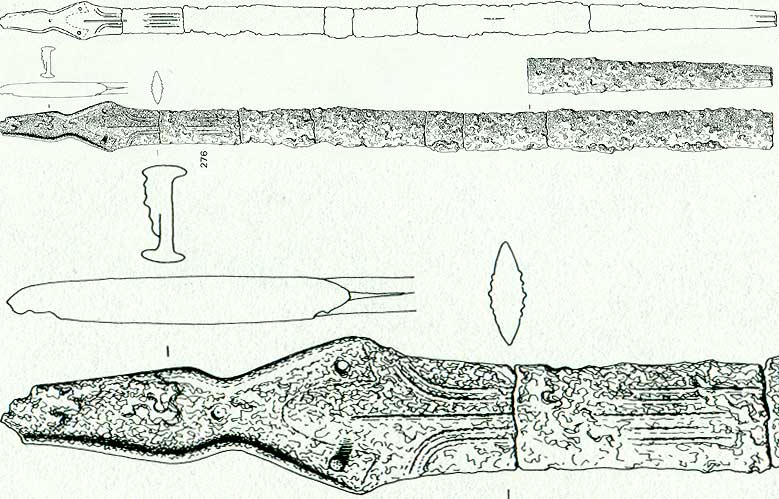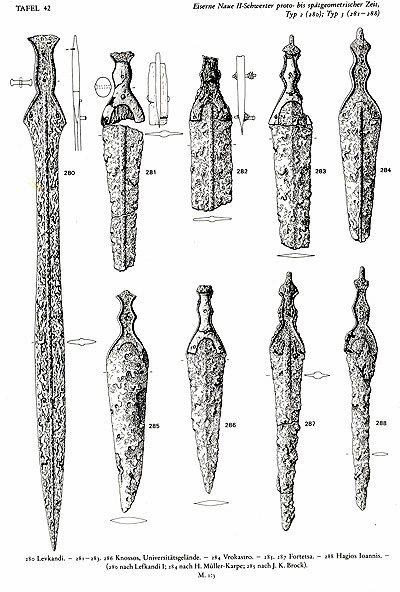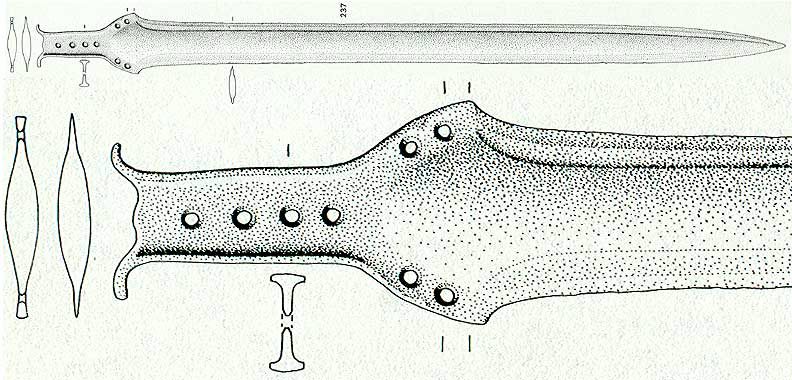| Author |
Message |
Scott Roush
Industry Professional

Location: Washburn, WI Joined: 27 Jan 2011
Posts: 452
|
 Posted: Thu 17 Feb, 2011 7:29 pm Post subject: were all-iron swords work hardened? Posted: Thu 17 Feb, 2011 7:29 pm Post subject: were all-iron swords work hardened? |
 |
|
I've been on this 'very early iron age' kick lately and am curious about swords that were constructed of wrought iron only... no steel.
I was just talking to somebody about the low carbon machetes and scythes that you sometimes find that are hammered to sharpness and hardness with a small anvil.
Were early swords perhaps done this way?
http://www.bigrockforge.com
|
|
   |
 |
Craig Johnson
Industry Professional

|
 Posted: Thu 17 Feb, 2011 8:16 pm Post subject: Edge stressing Posted: Thu 17 Feb, 2011 8:16 pm Post subject: Edge stressing |
 |
|
Hi Scott
Some where others where not. It would have been something that they would have done in the traditions of working bronze as well but some of the pieces that I have seen show no signs of stressing the edges.
When we look at the piece that have been tested from the period of the earliest iron blades we see the bronze blades being just a bit harder than the iron when worked this way. The move to iron as the material of choice probably had more to do with economics and availability then the blades being considered superior.
Best
Craig
|
|
    |
 |
|
Jeroen Zuiderwijk
Industry Professional
|
 Posted: Fri 18 Feb, 2011 2:44 am Post subject: Posted: Fri 18 Feb, 2011 2:44 am Post subject: |
 |
|
Data on iron age swords is a lot harder to come by then for bronze age swords. Bronze age swords only had the edges hardened. The hardness was at its highest during the middle bronze age, then declined towards the end of the bronze age.This was probably due to the lead contents in later bronzes, which makes workhardening difficult. From the early iron age, no data is available on the iron quality nor hardening of the blades. From the late iron age, I have data on roughly 20 swords, most around 300BC. The iron in them varies a lot, from nearly pure to decent levels of carbon (around 0.7% IIRC). All were workhardened allover, with to roughly the same hardness, harder then the edges of bronze age swords. There were a few that were unhardened IIRC, but they had clearly been in a fire. Evidence of quench hardened celtic blades seem to appear towards the end of the iron age, but I don't have any direct data on these.
Jeroen Zuiderwijk
- Bronze age living history in the Netherlands
- Barbarian metalworking
- Museum photos
- Zip-file with information about saxes
|
|
   |
 |
Craig Johnson
Industry Professional

|
 Posted: Fri 18 Feb, 2011 5:38 am Post subject: Iron Info Posted: Fri 18 Feb, 2011 5:38 am Post subject: Iron Info |
 |
|
Hi Jeroen
Do the swords you have info on come from a region or are they continent wide? The info I was working from was a class in early iron production I took about 18 years ago  we built and ran a Birkenland style furnace for several days or so and looked a quite a bit of info on early iron production and artifacts. If I remember right much of the info was from Tylecoat and some from Pliener. we built and ran a Birkenland style furnace for several days or so and looked a quite a bit of info on early iron production and artifacts. If I remember right much of the info was from Tylecoat and some from Pliener.
We did look into some blades that were quite early but I fear I do not remember where they were from at this point. I have my notes around here somewhere but would need to go dig them out.
Best
Craig
|
|
    |
 |
Scott Roush
Industry Professional

Location: Washburn, WI Joined: 27 Jan 2011
Posts: 452
|
 Posted: Fri 18 Feb, 2011 7:59 am Post subject: Posted: Fri 18 Feb, 2011 7:59 am Post subject: |
 |
|
Thank you very much for the great info.
Looks like I may be forging out some wrought iron into a Naue II type design. What information is available on specific work hardening methods? Is it just basically forging the bevels down in the fire and then finishing cold? Are there hammer marks along the edge on the examples you mention??
http://www.bigrockforge.com
|
|
   |
 |
Dan Howard

|
 Posted: Fri 18 Feb, 2011 12:44 pm Post subject: Posted: Fri 18 Feb, 2011 12:44 pm Post subject: |
 |
|
|
What you are after is "bloomery iron". Wrought iron is the term usually given to refined pig iron or puddled iron made in the 18-19th centuries and is of a poorer quality than a lot of stuff early iron workers had available and less suitable for swords.
|
|
  |
 |
Scott Roush
Industry Professional

Location: Washburn, WI Joined: 27 Jan 2011
Posts: 452
|
 Posted: Fri 18 Feb, 2011 3:37 pm Post subject: Posted: Fri 18 Feb, 2011 3:37 pm Post subject: |
 |
|
You can make 'wrought iron' with bloomery methods. It is all about how much carbon and how much you refine it. Iron is pretty much iron.... From there it all comes down to alloys, how much slag, etc. I'm forging down some small bloom right now in my shop... The more foldings I do, the more refined it is. Even relatively modern 'wrought iron' is of vastly varying quality from highly refined 'blacksmith's dream' to slaggy wagon wheel stuff. If all you have is slaggy stuff... Cut it up, weld it, forge it a couple of times and it starts to clean up. I have a bar of the good stuff. But ideally you would rather make actual steel with your bloomery... Not iron.
I'm doing a smelt this spring from local ores using clay and rocks from my land as the furnace.... I hope to do something similar with the bloom but I hope not to have to work harden it!
http://www.bigrockforge.com
|
|
   |
 |
Dan Howard

|
 Posted: Fri 18 Feb, 2011 5:00 pm Post subject: Posted: Fri 18 Feb, 2011 5:00 pm Post subject: |
 |
|
|
Apparently bloomery iron handles differently under the hammer. Thomas Powers is the man to ask about this
|
|
  |
 |
Scott Roush
Industry Professional

Location: Washburn, WI Joined: 27 Jan 2011
Posts: 452
|
 Posted: Fri 18 Feb, 2011 5:54 pm Post subject: Posted: Fri 18 Feb, 2011 5:54 pm Post subject: |
 |
|
From my somewhat limited experience, as the bloom becomes more refined (by forging out slag) it becomes easier to keep together just like wrought. When you say 'quality' in this context, I think ancient bloomery iron is no different when it comes to slag. They could refine it just as easily as modern wrought can be refined. But I think 'quality' had more to do with presence or absence of alloys that made the iron more conducive to work hardening and this probably reflected regional variances as mentioned by the others above. And... Of course... Quality could be measured by carbon content and the skill of the smelter...
http://www.bigrockforge.com
|
|
   |
 |
|
Jeroen Zuiderwijk
Industry Professional
|
|
   |
 |
|
Jeroen Zuiderwijk
Industry Professional
|
 Posted: Mon 21 Feb, 2011 2:12 pm Post subject: Posted: Mon 21 Feb, 2011 2:12 pm Post subject: |
 |
|
| Scott Roush wrote: | Thank you very much for the great info.
Looks like I may be forging out some wrought iron into a Naue II type design. What information is available on specific work hardening methods? Is it just basically forging the bevels down in the fire and then finishing cold? |
Far from it. They are some of the most difficult to forge sword blades in history. A lot of them have standing midribs (some multiple ridges). The iron ones are generally too poorly preserved to show the details one the edge. But bronze ones frequently have the edges hollow hammered/ground, with clearly defined bevels. Just to give some examples of what they got up to in those days (two with iron examples and a bronze one showing the detailed edge bevels). These are the more fancy examples though.
 Attachment: 73.94 KB Attachment: 73.94 KB

 Attachment: 83.66 KB Attachment: 83.66 KB

 Attachment: 71.34 KB Attachment: 71.34 KB

Jeroen Zuiderwijk
- Bronze age living history in the Netherlands
- Barbarian metalworking
- Museum photos
- Zip-file with information about saxes
|
|
   |
 |
Scott Roush
Industry Professional

Location: Washburn, WI Joined: 27 Jan 2011
Posts: 452
|
 Posted: Wed 23 Feb, 2011 2:57 pm Post subject: Posted: Wed 23 Feb, 2011 2:57 pm Post subject: |
 |
|
My goodness... there is a lot of detail on those.. yes.. not easy. But I was mostly wondering about the technique of work hardening itself. But I think I have that down now... I will do a 'test' where I find out how deep the hardening goes so I will know at what point I can grind for finishing and still have 'hard' iron.
Thank you for posting those pictures....
http://www.bigrockforge.com
|
|
   |
 |
Jared Smith

|
 Posted: Thu 24 Feb, 2011 2:54 pm Post subject: Posted: Thu 24 Feb, 2011 2:54 pm Post subject: |
 |
|
You can find examples of both heat treated (yes having sufficient carbon to form martensite at least in local zones), and cold work hardened high phosphorous iron alloys. An article on Merovingian spear and axe head artifacts, estimated to be 6th century A.D. , shows cross sections of iron grain indicating both. It has been linked here previously, and I recently used images of the close up detail of the iron-carbon grain phases from it for a Boy Scout metalworking merit badge. My theory is that some craftsmen probably adapted methods best suited to the local supply of alloys that they had.
Absence of evidence is not necessarily evidence of absence!
|
|
  |
 |
|
|

